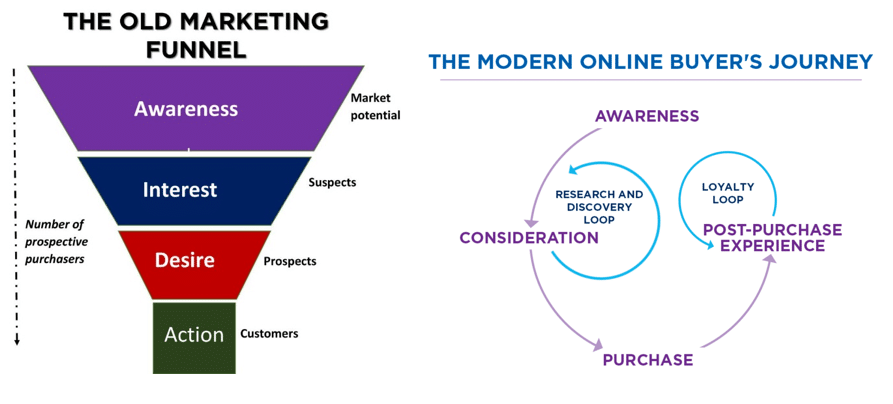
Beginner’s Guide To Attribution Modelling
What is an attribution model?
According to Google, the attribution model is the rule or set of rules that determine how the credit for a sale or conversion is assigned to the touchpoint throughout the consumer journey.
A consumer journey is never as linear as shown in the old consumer journey funnel below.
These days consumers have a lot more choices/platforms available at their fingertips for research. Chances are, most consumers will do their research from multiple channels such as display, search, organically but they might convert through a completely different channel, in this case, it could be Google shopping.
Just surviving is not an option, especially in today’s climate. Companies need to find out new ways to thrive in today’s competitive landscape.
In order to do that successfully, businesses need to understand their consumer’s behaviour and decision-making process.
This is where the attribution model can prove to be a useful tool as it can allow businesses to see the touchpoint throughout the consumer journey that led to the conversion. This allows businesses to understand how to better position themselves and which channel to target more or less.
Types of Attribution Models
Google currently offers six attribution models to help understand consumer converting journeys. There are other platforms/tools that offer attribution modelling but for the sake of simplicity, we will just be looking at the models offered by Google.
Last click model
This is the default model and most widely used model out of the six. The last click model assigns all the points to the very last click that led to the conversion.
First click model
It assigns all the points to the very first click within the consumer conversion journey.
For example: if a user first went to the brand website through the Facebook ad but then converted through the Search ad, google will still assign all the points to Facebook ads since we are using the first click model.
Linear
Google will assign points evenly to all touchpoints. Meaning, if a consumer went to the website from the display, social & organic channels before finally converting through the search ad, Google will still split the points evenly amongst all the channels due to linear attribution model.
Time decay
Google gives more credit to clicks that happened closer in time just before the conversion happens. If a consumer went to 4 different channels before converting then the time decay model will give more points to the last 2 channels compared to the others since they were much closer to the conversion.
Position based
Google gives more points to the first and last channel and splits the rest evenly in the middle. In this case, If a user used direct, email, social and converted via the organic channel. Google will give 40% points each to the direct & Organic channel (first and last). The remaining 20% will be split evenly between email & social channels.

I hope this has provided you with some basic information on what are attribution models?
Each attribution model is best suited for different scenarios. Opinions tend to be mixed on which attribution model to pick. It’s better to experiment with different attribution models to figure out what works best for you specifically.
To learn more about PPC & other aspects of digital marketing, subscribe to our pages on social media or contact us for PPC Training today by following this link.




